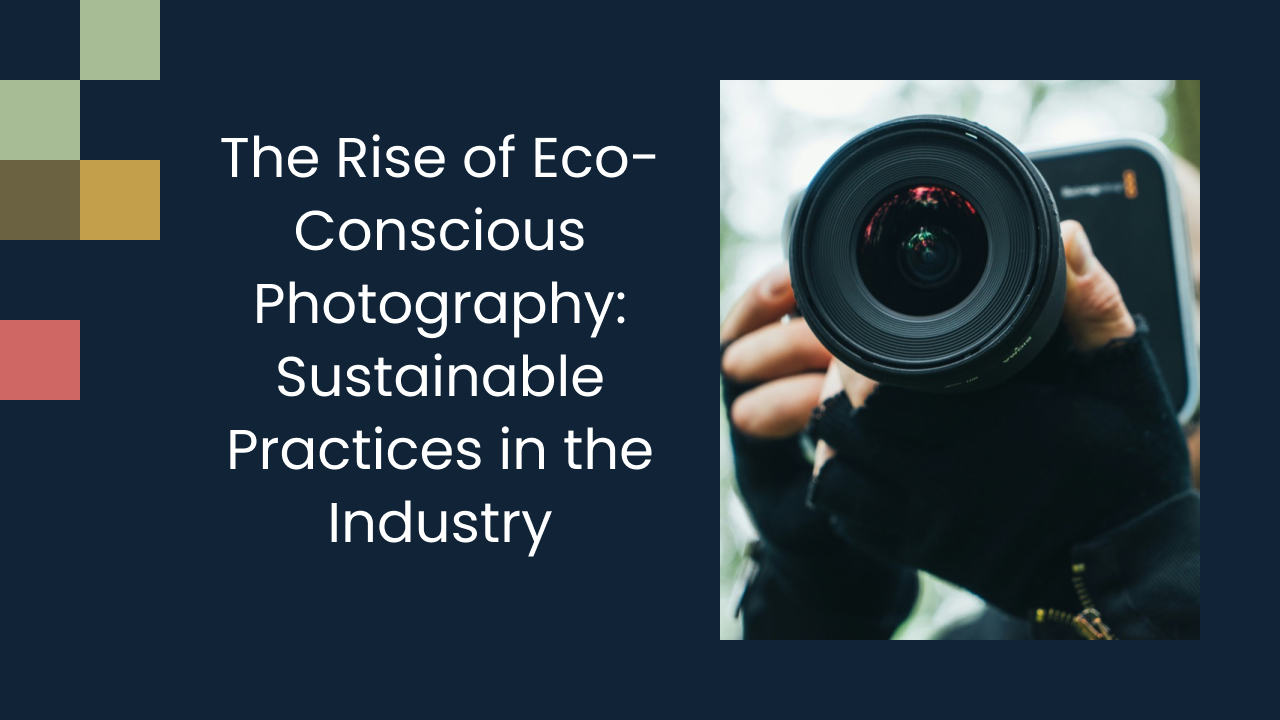Eco-Friendly Photography: Tips for Reducing Environmental Impact
In today's world, where environmental concerns are at the forefront of our minds, it's important for every industry to find ways to reduce their impact on the planet. The field of photography is no exception. From the manufacturing of equipment to the disposal of photography materials, the carbon footprint and waste generated by photography can be significant. However, with some conscious choices and adjustments, photographers can transition to a more eco-friendly approach.
Understanding the Environmental Impact of Photography
Before we delve into tips for reducing the environmental impact of photography, it's essential to understand the specific areas where this impact occurs.
Firstly, let's consider the carbon footprint of photography. This includes the carbon emissions associated with manufacturing photography equipment, transportation, and energy consumption during the editing and printing processes. The production of cameras, lenses, and other gear involves mining raw materials, manufacturing components, and assembling the final products, all of which contribute to greenhouse gas emissions. Transportation of these items from factories to stores and eventually to photographers also adds to the carbon footprint. Furthermore, the energy-intensive processes of editing photos on computers and printing them out on paper or other materials further contribute to carbon emissions.
Moreover, the waste generated in the photography industry is a significant concern. This waste includes not only plastic packaging but also chemicals used in the development process. The disposal of old or broken photography equipment poses environmental challenges as electronic waste can leach harmful substances into the soil and water if not properly recycled. Additionally, the chemicals used in traditional film development, such as fixers and developers, can be toxic if not disposed of correctly. Finding sustainable ways to manage and reduce this waste is crucial for minimizing the environmental impact of photography.
Transitioning to Eco-Friendly Photography
Transitioning to eco-friendly photography may seem daunting, but small changes can make a big difference. Let's explore some practical steps you can take to minimize your environmental impact while still capturing stunning images.
One effective way to make your photography practice more sustainable is by considering the entire lifecycle of your equipment. When choosing sustainable photography equipment, opt for brands that prioritize eco-conscious practices. Look for companies that not only use recycled materials but also have energy-efficient manufacturing processes. Additionally, seek out brands that offer take-back programs for old equipment, ensuring that your gear is properly recycled or repurposed.
Choosing Sustainable Photography Equipment
When it comes to selecting gear, consider investing in second-hand equipment whenever possible. Not only does this reduce your carbon footprint by giving new life to existing products, but it can also save you money. Another eco-friendly option is to choose equipment that allows for modular upgrades. By opting for cameras and accessories with interchangeable parts, you can upgrade specific components without needing to replace the entire device, extending the lifespan of your gear.
Moreover, embracing a circular economy approach in photography means supporting brands that prioritize sustainability in their production processes. Look for certifications such as Energy Star or EPEAT to ensure that your equipment meets high environmental standards.
Adopting Green Photography Practices
Adopting green photography practices can significantly reduce your environmental impact while enhancing the quality of your work. Start by planning your shoots thoughtfully to minimize unnecessary travel and transportation. Consider carpooling with colleagues, using public transportation, or even cycling to locations to reduce carbon emissions.
During photo sessions, be conscious of your energy consumption. Opt for natural lighting whenever possible to reduce reliance on artificial sources. When additional lighting is needed, choose energy-efficient LED lights that consume less power and have a longer lifespan. Alternatively, explore using reflectors or diffusers to manipulate natural light creatively, minimizing the need for electricity-consuming equipment.
Tips for Reducing Environmental Impact
Aside from transitioning to eco-friendly equipment and practices, there are several additional steps you can take to further reduce your environmental impact.
One effective way to reduce your environmental impact in photography is by being mindful of the chemicals used in the development process. Opt for non-toxic alternatives to traditional photo processing chemicals to minimize harm to the environment and your health. Look for eco-friendly options that are biodegradable and safe for disposal.
Minimizing Energy Consumption in Photography
When editing your photographs, be conscious of energy consumption. Close unnecessary programs and use power-saving settings on your computer. Consider investing in energy-efficient equipment and turn them off when not in use.
Furthermore, consider utilizing natural light whenever possible during photoshoots to reduce the need for artificial lighting. Not only does this help lower energy consumption, but it can also add a unique quality to your photographs with its soft and flattering illumination.
Additionally, explore green web hosting options for your online portfolio or website. These web hosting providers use renewable energy sources, reducing the carbon footprint associated with hosting your photography online.
Reducing, Reusing, and Recycling Photography Materials
An important aspect of eco-friendly photography is minimizing waste. Start by reducing the use of single-use materials like disposable lens cleaning wipes. Instead, opt for reusable cleaning cloths made from microfiber.
When it comes to printing, consider using recycled paper and eco-friendly inks. If possible, print only when necessary, and consider digital alternatives such as sharing your work online or using digital frames to display your photographs.
Another way to reduce waste in photography is by repurposing old equipment. Instead of discarding outdated cameras or lenses, consider donating them to schools or community centers to give them a second life. This not only reduces electronic waste but also provides opportunities for others to explore the art of photography.
Digital Photography and the Environment
While traditional film photography poses unique challenges in terms of its environmental impact, digital photography has its own pros and cons.
As technology continues to advance, the world of digital photography is constantly evolving. From mirrorless cameras to smartphone photography, there are a plethora of options available for capturing stunning images while considering environmental implications.
The Pros and Cons of Digital Photography
One of the advantages of digital photography is the elimination of film processing chemicals, which reduces chemical waste. Digital photographs can be stored digitally, reducing the need for physical storage space and materials.
Moreover, the versatility of digital photography allows for instant sharing and editing, reducing the need for physical prints and paper wastage. However, it's essential to acknowledge that the production of digital cameras and other equipment still contributes to carbon emissions. Additionally, the energy consumption associated with editing, processing, and storing digital photographs should not be overlooked.
Making Digital Photography More Sustainable
To make digital photography more sustainable, consider using energy-efficient devices and batteries. Practice efficient file management to eliminate unnecessary digital clutter, which can reduce storage needs and energy consumption.
Furthermore, exploring alternative power sources such as solar chargers for cameras can help reduce reliance on traditional energy grids. When it comes to backups and storage, consider cloud storage options that rely on renewable energy sources. This can further reduce the carbon footprint of your photography and contribute to a more sustainable future for the art form.
The Future of Eco-Friendly Photography
The photography industry is continuously evolving, and so are the efforts to make it more sustainable and eco-friendly.
With the increasing awareness of environmental issues, the future of eco-friendly photography looks promising. Photographers, equipment manufacturers, and consumers are all playing a part in driving this positive change towards a greener industry.
Innovations in Green Photography
As technology advances, we can expect further innovations in green photography. From sustainable materials used in equipment manufacturing to the development of energy-efficient lighting solutions, these innovations aim to reduce environmental impact.
One exciting development in green photography is the rise of eco-friendly camera accessories. Companies are now producing camera bags made from recycled materials, sustainable tripods, and even biodegradable camera straps. These eco-conscious accessories not only reduce waste but also showcase a commitment to sustainability within the photography community.
Advocacy and Legislation for Sustainable Photography
Advocacy and legislation play a crucial role in promoting sustainable practices within the photography industry. By advocating for environmentally friendly regulations and certifications, photographers can contribute to lasting change. Additionally, supporting and investing in companies that prioritize sustainability can drive industry-wide shifts toward greener practices.
Photographers are also joining forces to create eco-friendly photography collectives, where members share tips on reducing their carbon footprint, promote sustainable photo printing services, and organize community clean-up events. These collectives serve as a platform for like-minded individuals to collaborate and inspire each other to make a positive impact on the environment.
In conclusion, eco-friendly photography is not only achievable but essential for reducing the industry's environmental impact. By understanding the specific areas of impact and implementing sustainable practices, we can create a more sustainable future for photography. So, let's embrace these tips for reducing our environmental impact and pave the way for a greener photography industry.
Looking for an easier way to manage and grow your studio? Experience a platform built by a photographer, for photographers. Try it free for 2 weeks.











